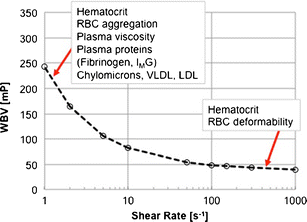

There has long been indirect evidence linking thrombosis and elevated RBC volume (Hematocrit), through effect upon blood rheological properties. Adapted with permission from Byrnes and Wolberg ( 2). In disease states, abnormal RBCs and RBC-derived microvesicles may also adhere to the endothelium or extracellular matrix, activate platelets and other cells, and enhance local thrombin generation during thrombosis. Once incorporated into venous thrombi, RBCs increase thrombus size and reduce thrombus permeability and susceptibility to lysis. RBCs can also directly or indirectly adhere to the vessel wall and may contribute to thrombin generation within thrombi. In veins, RBC aggregation into stacked rouleaux structures increases blood viscosity. (B) Venous thrombi form slowly in stasis or low flow (frequently in venous valve pockets) and are RBC and fibrin rich. Although RBCs increase blood viscosity, this effect is lessened in arteries by high shear-induced shape change. During arterial thrombosis, RBCs promote platelet margination, increase platelet-thrombus interactions, and enhance platelet adhesion and activation. (A) Arterial thrombi arise in vessels with high shear rates, which promotes the rapid formation of platelet-rich thrombi. Potential contributions of normal and abnormal RBCs to arterial and venous thrombosis/thromboembolism. Here, we review the above mechanisms of RBC contribution to hemostasis.įigure 1. Finally, blood clot structure and maturation are dependent on the inclusion of RBCs in forming thrombi. Additionally, RBCs generate microparticles which have been shown to reduce clotting time. RBC surface interactions govern signaling between platelets and RBCs and also aid in the conversion of prothrombin to thrombin. Of note, morphologic pathology, such as that found in sickle cell disease, leads to increased risk of thrombotic disease. First and foremost, RBC biomechanics are the principal determinant of viscosity and flow dynamics of blood, which strongly influence all features of hemostasis.

Red Blood Cells (RBCs) have been increasingly recognized to play important roles in hemostasis and the mechanisms by which they do so continue to be elucidated. 2Division of Pediatric Critical Care Medicine, The Center for Blood Oxygen Transport and Hemostasis, University of Maryland School of Medicine, Baltimore, MD, United States.1Division of Pediatric Hematology and Oncology, Oregon Health and Sciences University, Portland, OR, United States.


 0 kommentar(er)
0 kommentar(er)
